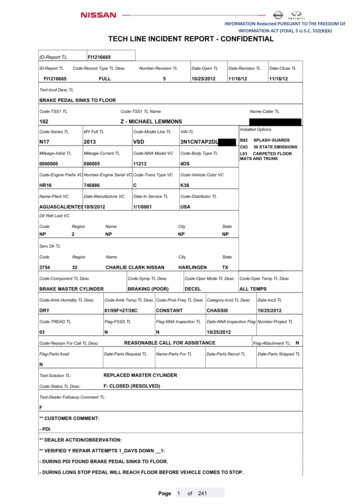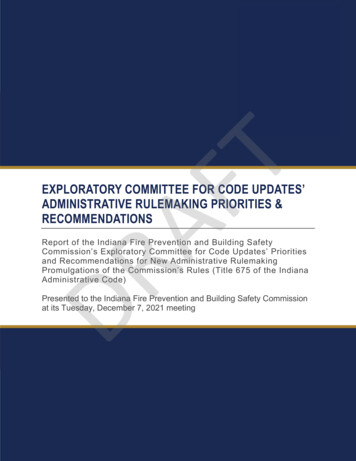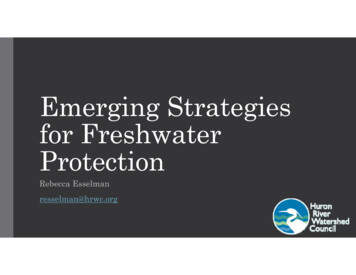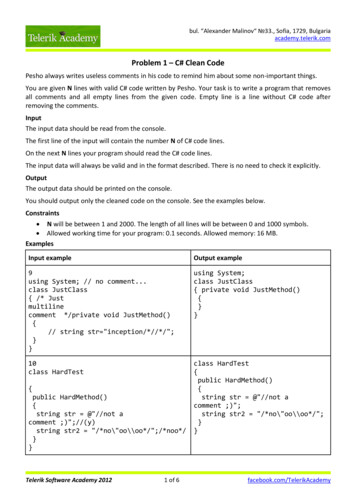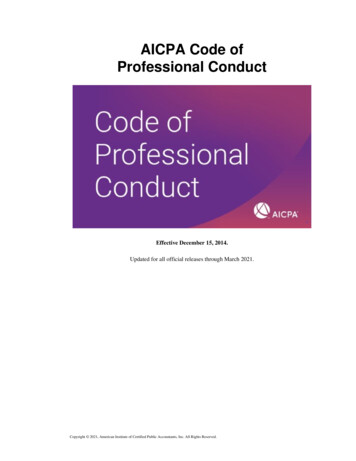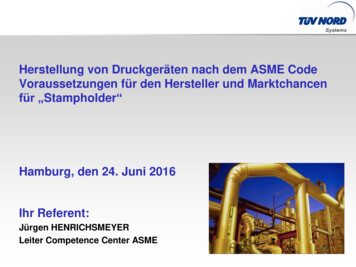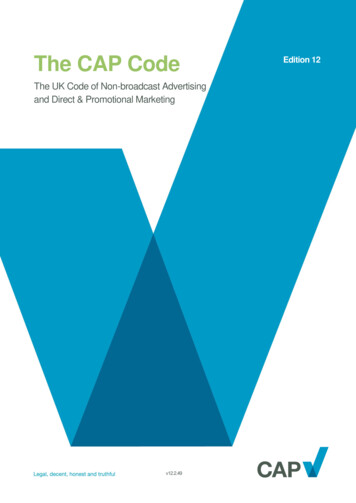
Transcription
The CAP CodeThe UK Code of Non-broadcast Advertisingand Direct & Promotional Marketingv12.2.49Edition 12
ContentsPrefaceIntroductionGeneral Section1Compliance102Recognition of marketing communications133Misleading advertising154Harm and offence255Children286Privacy327Political advertisements348Promotional Marketing369Distance selling4510 USE OF DATA FOR MARKETING4711 Environmental claims5312 Medicines, medical devices, health-related products and beauty products 5613 Weight control and slimming6314 Financial products6715 Food, food supplements and associated health or nutrition claims7016 Gambling7717 Lotteries8118 Alcohol8419 Motoring8820 Employment, homework schemes and business opportunties9021 Tobacco, rolling papers and filters9322 Electronic cigarettes9623 How the system works10024 History of self-regulation11125 Appendix 1: The CPRs and BPRs11426 Appendix 2: Advertising rules for on-demand services regulated by statute11827The UK Code of Non-broadcast Advertising and Direct & Promotional Marketing2
PrefaceIn the UK, The UK Code of Non-broadcast Advertising and Direct & PromotionalMarketing(the Code) is the rule book for non-broadcast advertisements, salespromotions and direct marketing communications (marketing communications). TheCode is primarily concerned with the content of marketing communications and not withterms of business or products themselves. Some rules, however, go beyond content; forexample, those that cover the administration of sales promotions, the suitability ofpromotional items, the delivery of products ordered through an advertisement and theuse of personal information in direct marketing. Editorial content is specifically excludedfrom the Code, though it might be a factor in determining the context in which marketingcommunications are judged.The Committee of Advertising Practice (CAP) is the self-regulatory body that creates,revises and enforces the Code. CAP's members include organisations that representthe advertising, sales promotion, direct marketing and media businesses. Through theirmembership of CAP member organisations, or through contractual agreements withmedia publishers and carriers, those businesses agree to comply with the Code so thatmarketing communications are legal, decent, honest and truthful and consumerconfidence is maintained.Some CAP member organisations, for example, the Data & Marketing Association andthe Proprietary Association of Great Britain, also require their members to observe theirown codes of practice. Those codes may cover some practices that are not covered inthis Code.The Code supplements the law, fills gaps where the law does not reach and oftenprovides an easier way of resolving disputes than by civil litigation or criminalprosecution. In many cases, self-regulation ensures that legislation is not necessary.Although advertisers, promoters and direct marketers (marketers), agencies and mediamay still wish to consult lawyers, compliance with the Code should go a long way toensuring compliance with the law in areas covered by both the Code and the law.By creating and following self-imposed rules, the marketing community producesmarketing communications that are welcomed and trusted. By practising self-regulation,it ensures the integrity of advertising, promotions and direct marketing.The value of self-regulation as an alternative to statutory control is recognised in ECDirectives, including those on misleading and comparative advertising (Directives2005/29/EC and 2006/114/EC). Self-regulation is accepted by the Department forBusiness, Innovation and Skills and Trading Standards as a first line of control inprotecting consumers and the industry.The Advertising Standards Authority (ASA) is the independent body that endorses andadministers the Code, ensuring that the self-regulatory system works in the publicinterest. The ASA's activities include investigatingand rulingon complaints andThe UK Code of Non-broadcast Advertising and Direct & Promotional Marketing3
conducting research. Full information about the ASA's complaints procedure is availableon www.asa.org.uk.The vast majority of advertisers, promoters and direct marketers comply with the Code.Those that do not may be subject to sanctions. Adverse publicity may result from therulings published by the ASA weekly on its website. The media, contractors and serviceproviders may withhold their services or deny access to space. Trading privileges(including direct mail discounts) and recognition may be revoked, withdrawn ortemporarily withheld. Pre-vetting may be imposed and, in some cases, noncomplyingparties can be referred to Trading Standards for action, where appropriate, under theConsumer Protection from Unfair Trading Regulations 2008 or the Business Protectionfrom Misleading Marketing Regulations 2008.The successful track record of the self-regulatory system meant that the ASA wasrecognised as the natural co-regulatory partner when Ofcom was required to give effectto European Union legislation governing advertising content on relevant on-demandservices. The ASA was designated by Ofcom as the co-regulator of advertising contentincluded in on-demand services with effect from August 2010. The statutoryrequirements applying to certain on-demand services are reflected in the rules set out inAppendix 2 in this document.The system is structured so that it does not operate in an unfair or anti-competitivemanner or restrict free speech unjustifiably. ASA decisions are subject to independentreview, including in exceptional cases by the Administrative Division of the High Court.The full text of the Code is available at: g-codes/non-broadcast-code.html.CAPt 020 7492 2200 f020 7404 3404e enquiries@cap.org.ukwww.cap.org.ukASAt 020 7492 2222 f 020 7242 3696e enquiries@asa.org.ukwww.asa.org.ukCastle House,37-45 Paul Street,London,EC2A 4LSCopyright The Committee of Advertising Practice 2014.The UK Code of Non-broadcast Advertising and Direct & Promotional Marketing4
IntroductionThis twelfth edition of the Code comes into force on 1 September 2010. It replaces allprevious editions.As well as this Code, non-broadcast marketing communications are subject tolegislation. See www.cap.org.uk for a non-exhaustive list.The advertising rules that apply to video-on-demand services which are subject tostatutory regulation are reflected in the rules set out in Appendix 2.I The Code applies to:a. advertisements in newspapers, magazines, brochures, leaflets, circulars, mailings, emails, text transmissions (including SMS and MMS), fax transmissions, catalogues,follow-up literature and other electronic or printed materialb. posters and other promotional media in public places, including moving images,except where they appear unlawfullyc. cinema, video, DVD and Blu-ray advertisementsd. advertisements in non-broadcast electronic media, including but not limited to: onlineadvertisements in paid-for space (including banner or pop-up advertisements and onlinevideo advertisements); paid-for search listings; preferential listings on price comparisonsites; viral advertisements (see III l); in-game advertisements; commercial classifiedadvertisements; advergames that feature in display advertisements; advertisementstransmitted by Bluetooth; advertisements distributed through web widgets and onlinepromotions and prize promotionse. marketing databases containing consumers' personal informationf. promotions in non-broadcast mediag. advertorials (see III k)h. Advertisements and other marketing communications by or from companies,organisations or sole traders on their own websites, or in other non-paid-for space onlineunder their control, that are directly connected with the supply or transfer of goods,services, opportunities and gifts, or which consist of direct solicitations of donations aspart of their own fund-raising activities.II The Code does not apply to:a. broadcast advertisements (The BCAP Code sets out the rules that govern broadcastadvertisements on any television channel or radio station licensed by Ofcom)The UK Code of Non-broadcast Advertising and Direct & Promotional Marketing5
b. the contents of premium-rate services, which are the responsibility of the Phone-paidServices Authority; marketing communications that promote those services are subjectto Phone-paid Services Authority regulation and to the CAP Codec. marketing communications in foreign media. Direct marketing communications thatoriginate outside the United Kingdom and promotions and marketing communicationson non-UK websites, if targeted at UK consumers, are subject to the jurisdiction of therelevant authority in the country from which they originate if that authority operates asuitable cross-border complaint system. If it does not, the Advertising StandardsAuthority (ASA) will take what action it can. Most members of the European Union, andmany non-European countries, have a self-regulatory organisation that is a member ofthe European Advertising Standards Alliance (EASA). EASA co-ordinates the crossborder complaints system for its members (which include the ASA)d. claims, in marketing communications in media addressed only to medical, dental,veterinary or allied practitioners, that relate to those practitioners' expertisee. classified private advertisements, including those appearing onlinef. statutory, public, police and other official notices or information, but not marketingcommunications, produced by public authorities and the likeg. works of art exhibited in public or privateh. private correspondence, including correspondence between organisations and theircustomers about existing relationships or past purchasesi. live oral communications, including telephone calls and announcements or directapproaches from street marketersj. press releases and other public relations material not covered by part I abovek. editorial content; for example, of the media or of books and regular competitions suchas crosswordsl. [Deleted 10 May 2018].m. packages, wrappers, labels, tickets, timetables and price lists unless they advertiseanother product or a promotion or are visible in a marketing communicationn. point-of-sale displays, except those covered by the promotional marketingrules or therolling paper and filter ruleso. political advertisements as defined in Section 7The UK Code of Non-broadcast Advertising and Direct & Promotional Marketing6
p. marketing communications for causes and ideas in non-paid-for space, except wherethey contain a direct solicitation for donations as part of the marketer's own fund-raisingactivitiesq. website content not covered by I d and I h, including (but not limited to) editorialcontent, news or public relations material, corporate reports and natural listings on asearch engine or a price comparison siter. sponsorship; marketing communications that refer to sponsorship are covered by theCodes. customer charters and codes of practicet. investor relations (see III m)u. 'heritage advertising' by or from companies, organisations or sole traders on their ownwebsites, or in other non-paid for space online under their control, where that advertisingis not part of their current promotional strategy and is placed in an appropriate context.In cases where advertisements or other marketing communications recentlyruledagainst by the ASA are featured, rule 1.2 (the spirit of the Code) may be invoked to bringthose advertisements or other marketing communications within remit.III These definitions apply to the Code:a. a product encompasses goods, services, ideas, causes, opportunities, prizes or giftsb. a consumer is anyone who is likely to see a given marketing communication, whetherin the course of business or notc. the United Kingdom covers the Isle of Man and the Channel Islandsd. a claim can be implied or direct, written, spoken or visual; the name of a product canconstitute a claime. the Code is divided into numbered rulesf. a marketing communication includes all forms of communication listed in part Ig. a marketer includes an advertiser, promoter or direct marketerh. a supplier is anyone who supplies a product that is sold by a distance-sellingmarketing communication (and can be the marketer)i. a child is anyone under 16j. a corporate subscriber includes corporate bodies such as limited companies in theUK, limited liability partnerships in England, Wales and Northern Ireland or anypartnerships in Scotland. It also includes schools, hospitals, Government departmentsThe UK Code of Non-broadcast Advertising and Direct & Promotional Marketing7
or agencies and other public bodies. It does not include sole traders or non-limitedliability partnerships in England, Wales and Northern Ireland. See rule 10.14k. An advertorial is an advertisement feature, announcement or promotion, the contentof which is controlled by the marketer, not the publisher, that is disseminated inexchange for a payment or other reciprocal arrangementl. A viral advertisement is an e-mail, text or other non-broadcast marketingcommunication designed to stimulate significant circulation by recipients to generatecommercial or reputational benefit to the marketer. Viral advertisements are usually putinto circulation ("seeded") by the marketer with a request, either explicit or implicit, for themessage to be forwarded to others. Sometimes they include a video clip or a link towebsite material or are part of a promotional campaignm. Investor relations material is information about an organisation (including its goods orservices) addressed to the financial community, including shareholders and investors,as well as others who might be interested in the company's stock or financial stability.IV These criteria apply to the Code:a. the ASA Council's interpretation of the Code is finalb. if it is not clear whether a communication falls within the remit of the Code, the ASAwill be more likely to apply the Code if the material complained about is in paid-for spacec. compliance with the Code is assessed according to the marketing communication'sprobable impact when taken as a whole and in context. That will depend on the mediumin which the marketing communication appeared, the audience and its likely response,the nature of the product and any material distributed to consumersd. the Non-broadcast ASA Council may have regard to decisions made by theBroadcast ASA Council under the BCAP Code and, similarly, the Broadcast ASACouncil may have regard to decisions made by the Non-broadcast ASA Council underthe CAP Code. Factors that help to determine whether an ASAruling is likely to applyacross media include, but are not limited to, the characteristics of the medium, how theadvertisement is targeted, the context in which a claim is made and the extent to whichthe relevant CAP Code provisions correspond to those in the BCAP Codee. the Code does not have the force of law and its interpretation will reflect its flexibility.The Code operates alongside the law; the Courts may make rulings on matters coveredby the Codef. an indication of the statutory rules governing marketing communications is given onwww.cap.org.uk; professional advice should be taken about their applicationThe UK Code of Non-broadcast Advertising and Direct & Promotional Marketing8
g. no spoken or written communication from the ASA or CAP should be understood ascontaining legal adviceh. the Code is primarily concerned with the content of advertisements, promotions anddirect marketing communications and not with terms of business or products. Somerules, however, go beyond content; for example, those that cover the administration ofpromotions, the suitability of promotional itemsand the use of personal information indirect marketing. Editorial content is specifically excluded from the remit of the Code(see II k) although it might be a factor in determining the context in which a marketingcommunication is judged (see IV c)i. the Code makes due allowance for public sensitivities but will not be used by the ASAto diminish freedom of speech unjustifiablyj. the ASA does not arbitrate between conflicting ideologiesk. in assessing compliance with the Code, the ASA may take account of honest marketpractices and the general principle of good faith in the traders' field of activityl. in relevant cases the ASA will have regard to existing statutory enforcement bodies.The ASA reserves the right to refer complainants to the relevant statutory regulator incases where a complaint about a marketing communication relates to a Code rule thatreflects a legal provision for a regulated product.The UK Code of Non-broadcast Advertising and Direct & Promotional Marketing9
1COMPLIANCE
COMPLIANCEPrincipleThe central principle for all marketing communications is that they should be legal,decent, honest and truthful. All marketing communications should be prepared with asense of responsibility to consumers and society and should reflect the spirit, not merelythe letter, of the Code.BackgroundMarketers should use the ASA website, www.asa.org.uk, or the CAP website,www.cap.org.uk, to inform themselves of recent ASA rulings, the latest text of the Codeand CAP guidance on the Code.The fact that a marketing communication complies with the Code does not guaranteethat every publisher will accept it. Media owners can refuse space to marketingcommunications that break the Code and are not obliged to publish every marketingcommunication offered to them.The ASA/CAP self-regulatory system is recognised by the Government, TradingStandards and the Courts as one of the "established means" of consumer protection innon-broadcast marketing communications. Any matter that principally concerns a legaldispute will normally need to be resolved through law enforcement agencies or theCourts.The ASA and CAP will treat in confidence any genuinely private or secret materialsupplied unless the Courts or officials acting within their statutory powers compel itsdisclosure.Rules1.1Marketing communications should be legal, decent, honest and truthful.1.2Marketing communications must reflect the spirit, not merely the letter, of theCode.1.3Marketing communications must be prepared with a sense of responsibility toconsumers and to society.1.4Marketers must comply with all general rules and with relevant sector-specificrules.1.5No marketing communication should bring advertising into disrepute.1.6Marketing communications must respect the principles of fair competitiongenerally accepted in business.The UK Code of Non-broadcast Advertising and Direct & Promotional Marketing11
COMPLIANCE1.7Any unreasonable delay in responding to the ASA's enquiries will normally beconsidered a breach of the Code.1.7.11.8The full name and geographical business address of the marketer must begiven to the ASA or CAP without delay if requested.Marketing communications must comply with the Code. Primary responsibilityfor observing the Code falls on marketers. Others involved in preparing orpublishing marketing communications, such as agencies, publishers and otherservice suppliers, also accept an obligation to abide by the Code.1.8.11.9[Deleted 6 November 2018]Marketers should deal fairly with consumers.Legality1.10Marketers have primary responsibility for ensuring that their marketingcommunications are legal. Marketing communications should comply with thelaw and should not incite anyone to break it.1.10.1Marketers must not state or imply that a product can legally be sold if itcannot.The UK Code of Non-broadcast Advertising and Direct & Promotional Marketing12
2RECOGNITION OFMARKETINGCOMMUNICATIONS
RECOGNITION OF MARKETING COMMUNICATIONSBackgroundOther sections of the Code contain product-specific or audience-specific rules that areintended to protect consumers from misleading marketing communications. Forexample, the Charity-linked Promotions and Children sections of the Code contain rulesthat apply, as well as the general rules, to marketing communications that fall underthose sections.Rules2.1Marketing communications must be obviously identifiable as such.2.2Unsolicited e-mail marketing communications must be obviously identifiable asmarketing communications without the need to open them (see rule 10.6).2.3Marketing communications must not falsely claim or imply that the marketer isacting as a consumer or for purposes outside its trade, business, craft orprofession; marketing communications must make clear their commercial intent,if that is not obvious from the context.2.4Marketers and publishers must make clear that advertorials are marketingcommunications; for example, by heading them "advertisement feature".The UK Code of Non-broadcast Advertising and Direct & Promotional Marketing14
3MISLEADINGADVERTISING
MISLEADING ADVERTISINGBackgroundThe ASA may take the Consumer Protection from Unfair Trading Regulations 2008 intoaccount when it rules on complaints about marketing communications that are allegedto be misleading. See Appendix 1 for more information about those Regulations.The ASA will take into account the impression created by marketing communications aswell as specific claims. It will rule on the basis of the likely effect on consumers, not themarketer's intentions.Other sections of the Code contain product-specific or audience-specific rules that areintended to protect consumers from misleading marketing communications. Forexample, the Children and Medicines sections of the Code contain rules that apply, aswell as the general rules, to marketing communications that fall under those sections.If a marketing communication encourages consumers to buy a product or servicethrough a distance-selling mechanism, marketers should seek legal advice to ensurethey comply with the Consumer Contracts (Information, Cancellation and AdditionalCharges) Regulations 2013.RulesGeneral3.1Marketing communications must not materially mislead or be likely to do so.3.2Obvious exaggerations ("puffery") and claims that the average consumer whosees the marketing communication is unlikely to take literally are allowedprovided they do not materially mislead.3.3Marketing communications must not mislead the consumer by omitting materialinformation. They must not mislead by hiding material information or presentingit in an unclear, unintelligible, ambiguous or untimely manner.Material information is information that the consumer needs to make informeddecisions in relation to a product. Whether the omission or presentation ofmaterial information is likely to mislead the consumer depends on the context,the medium and, if the medium of the marketing communication is constrainedby time or space, the measures that the marketer takes to make thatinformation available to the consumer by other means.3.43.4.1For marketing communications that quote prices for advertised products,material information [for the purposes of rule 3.3] includes:the main characteristics of the productThe UK Code of Non-broadcast Advertising and Direct & Promotional Marketing16
MISLEADING ADVERTISING3.4.2the identity (for example, a trading name) and geographical address of themarketer and any other trader on whose behalf the marketer is acting3.4.3the price of the advertised product, including taxes, or, if the nature of theproduct is such that the price cannot be calculated in advance, the mannerin which the price is calculated3.4.4delivery charges3.4.5the arrangements for payment, delivery, performance or complainthandling, if those differ from the arrangements that consumers are likely toreasonably expect3.4.6that consumers have the right to withdraw or cancel, if they have that right(see rule 3.55).3.5Marketing communications must not materially mislead by omitting the identityof the marketer.Some marketing communications must include the marketer's identity andcontact details. Marketing communications that fall under the Database Practiceor Employment sections of the Code must comply with the more detailed rulesin those sections.Marketers should note the law requires marketers to identify themselves insome marketing communications. Marketers should take legal advice.3.6Subjective claims must not mislead the consumer; marketing communicationsmust not imply that expressions of opinion are objective claims.Substantiation3.7Before distributing or submitting a marketing communication for publication,marketers must hold documentary evidence to prove claims that consumers arelikely to regard as objective and that are capable of objective substantiation. TheASA may regard claims as misleading in the absence of adequatesubstantiation.3.8Claims for the content of non-fiction publications should not exaggerate thevalue, accuracy, scientific validity or practical usefulness of the product.Marketers must ensure that claims that have not been independentlysubstantiated but are based merely on the content of a publication do notmislead consumers.CAP has published a Help Note on the Marketing of Publications.The UK Code of Non-broadcast Advertising and Direct & Promotional Marketing17
MISLEADING ADVERTISINGQualification3.9Marketing communications must state significant limitations and qualifications.Qualifications may clarify but must not contradict the claims that they qualify.3.10Qualifications must be presented clearly.CAP has published a Help Note on Claims that Require Qualification.Exaggeration3.11Marketing communications must not mislead consumers by exaggerating thecapability or performance of a product.3.12Marketing communications must not present rights given to consumers in lawas a distinctive feature of the marketer's offer.3.13Marketing communications must not suggest that their claims are universallyaccepted if a significant division of informed or scientific opinion exists.Prohibited claimsThese rules apply regardless of any substantiation presented in support of the claims:3.14Marketing communications must not claim that products can facilitate winning ingames of chance.3.15Marketing communications must not explicitly claim that the advertiser's job orlivelihood is in jeopardy if the consumer does not buy the advertised product.3.16No marketing communication may promote a pyramid promotional scheme.Pyramid promotional schemes are those in which consumers pay for theopportunity to receive payments derived primarily from the introduction of otherconsumers into the scheme, not from the sale or consumption of products.PricesBackgroundPrice statements in marketing communications should take into account the CharteredTrading Standards Institute’s Guidance for traders on pricing practices.DefinitionPrice statements include statements about the manner in which the price will becalculated as well as definite prices.The UK Code of Non-broadcast Advertising and Direct & Promotional Marketing18
MISLEADING ADVERTISING3.17Price statements must not mislead by omission, undue emphasis or distortion.They must relate to the product featured in the marketing communication.3.18Quoted prices must include non-optional taxes, duties, fees and charges thatapply to all or most buyers. However, VAT-exclusive prices may be given if allthose to whom the price claim is clearly addressed pay no VAT or can recoverVAT. Such VAT-exclusive prices must be accompanied by a prominentstatement of the amount or rate of VAT payable.3.19If a tax, duty, fee or charge cannot be calculated in advance, for example,because it depends on the consumer's circumstances, the marketingcommunication must make clear that it is excluded from the advertised priceand state how it is calculated.3.20Marketing communications that state prices must also state applicable delivery,freight or postal charges or, if those cannot reasonably be calculated inadvance, state that such charges are payable.3.21If the price of one product depends on another, marketing communicationsmust make clear the extent of the commitment the consumer must make toobtain the advertised price.3.22Price claims such as "up to" and "from" must not exaggerate the availability oramount of benefits likely to be obtained by the consumer.FreePrincipleMarketing communications must not describe a product as "free", "gratis", "withoutcharge" or similar if the consumer has to pay anything other than the unavoidable costof responding and collecting or paying for delivery of the item.3.23Marketing communications must make clear the extent of the commitment theconsumer must make to take advantage of a "free" offer.3.24Marketing communications must not describe items as "free" if:3.24.1the consumer has to pay packing, packaging, handling or administrationcharges for the "free" product3.24.2the cost of response, including the price of a product that the consumermust buy to take advantage of the offer, has been increased, except wherethe increase results from factors that are unrelated to the cost of thepromotion, orThe UK Code of Non-broadcast Advertising and Direct & Promotional Marketing19
MISLEADING ADVERTISING3.24.3the quality of the product that the consumer must buy has been reduced.CAP and BCAP have published joint guidance on the use of "free".3.25Marketers must not describe an element of a package as "free" if that element isincluded in the package price unless consumers are likely to regard it as anadditional benefit because it has recently been added to the package withoutincreasing its price.3.26Marketers must not use the term "free trial" to describe "satisfaction or yourmoney back" offers or offers for which a non-refundable purchase is required.Availability3.27Marketers must make a reasonable estimate of demand for advertisedproducts.3.28Marketing communications that quote a price for a featured product must stateany reasonable grounds the marketer has for believing that it might not be ableto supply the advertised (or an equivalent) product at the advertised price withina reasonable period and in reasonable quantities. In particular:3.
The UK Code of Non-broadcast Advertising and Direct & Promotional Marketing 5 Introduction This twelfth edition of the Code comes into force on 1 September 2010. It replaces all previous editions. As well as this Code, non-broadcast marketing communications are subject to legislation. See www.cap.org.uk for a non-exhaustive list.

